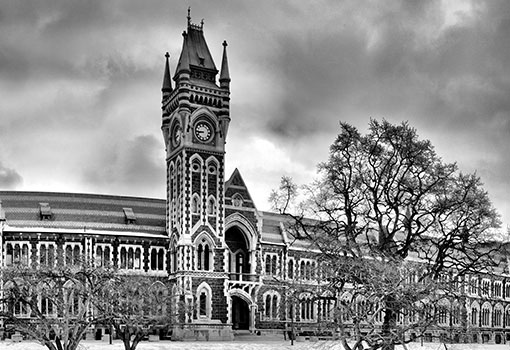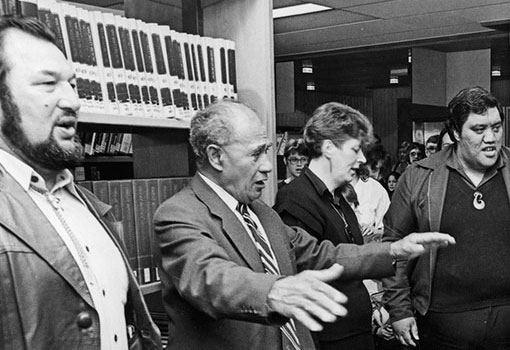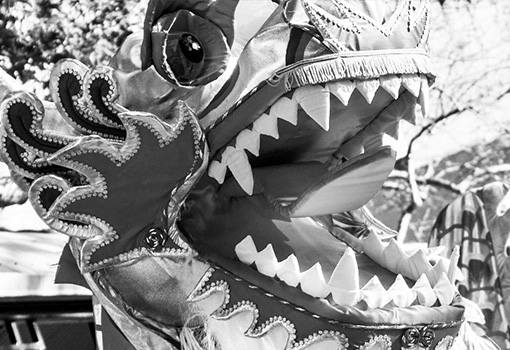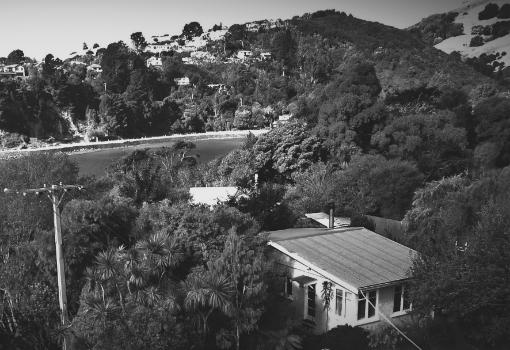
Book Review - Aftermaths: Colonialism, Violence and Memory in Australia, New Zealand and the Pacific
Posted: Monday May 01, 2023
An essay collection that confronts the violence of the colonial past, and the perils of forgetting.
In his extraordinary 2015 novel, The Buried Giant, the Nobel-Prize winning author Kazuo Ishiguro narrates a journey taken on foot by an elderly couple – living in a mythical past – to search for their son. The story begins with their recognition of disaffection: neither can fully remember where he now is or why he is gone. His mother, Beatrice, is desperate to reconnect with him before she dies. His father, Axl, bears an especial unease about taking a perilous journey in an unknown direction to meet a half-forgotten child.
As their journey progresses, we uncover the reasons for their inability to remember. A fog of forgetfulness extends over the valley in which they live and walk. The source of the fog is a dragon, ancient and dying, chained to a mountain by the region’s ruler with the express purpose of instilling forgetfulness. What they are supposed to forget is a terrible war, which occured when Axl and Beatrice were much younger, a conflict that pitched family against family and elicited extreme acts of violence. To ensure a ceasefire and break an inevitable chain of revenge actions, the ruler imprisoned the dragon and trapped the people in his breath of forgetfulness. He hoped that as soon as the generation who caused and experienced the violence died out, the dragon could be unchained, and subsequent generations could live in the eternal peace of collective amnesia.
However, Beatrice and Axl begin to recover their painful memories, and in these moments of hard-won clarity they struggle to reconcile themselves with the knowledge of their lives of violence and the generational harm they inflicted on their neighbours, on each other, and on their only child. Forgetting is not bliss but torture. Furthermore, Ishiguro suggests that it is only by working through the shock and trauma of remembering and acknowledging their complicitness that Beatrice and Axl can move on. Only through confronting the truth of the past can they find peace.
Ishiguro’s novel, set in a mythical post-Arthurian English valley, may seem a long way removed from an edited collection, compiled by some of the most exciting scholars in their respective fields, about the experiences and legacies of colonial violence in the trans-Pacific region, including in Aotearoa New Zealand. Yet Ishiguro’s fictional account of an imagined past – a past in which a taniwha lives with the power to cause others to forget – grapples with the same kind of challenges that the Aftermaths collection presents as a lived contemporary reality.
How do we tell stories of mamae? How do we reconcile our collective history of violence, displacement, and suffering, occasioned by the reality of colonialism, whose impacts and legacies continue to be disproportionately experienced by Indigenous communities in our present? How do we acknowledge this violence as a shared burden, and how do we accommodate that knowledge in such a way that we are able to take up our share of carrying this ‘emotional freight’ (in the words of two of the editors, Lyndall Ryan and Camille Nurka) that until now has ‘mostly been carried by Indigenous communities and families’? The questions are serious ones. They should confront and provoke. They demand an empathetic response.
For what Ishiguro’s novel and the Aftermaths collection highlight is that the luxury of forgetting – aided in no small part by our own dragons serving convenient doses of selective memory – is only afforded to some of us, and usually serves the interests of those in charge. While some of us may enjoy the priviledge of ‘not knowing’ or ‘not remembering’, in the end, much like Beatrice and Axl, the costs of convenient forgetfulness are enormous for everyone. The past haunts our present. Whether we like it or not, its violence affects the materiality of our collective lives, privileging some over others. What is so wonderful about the Aftermaths collection then is that it asks serious questions that should cause anyone living in the Pacific region, or (for that matter) in any colonial space, more than a moment’s pause.
It is a rare publication that can cross the difficult divide between academic history and accessible reading. Both the editors and Otago University Press should be commended for presenting the 23 chapters – including the introduction and conclusion – in such a way as to engage anyone who picks up this richly illustrated book. Every chapter is well-written and evocative. Aftermaths will open eyes.
Using a case-study approach, the collection reveals the histories of individuals, families and communities caught in various webs of colonial violence as victims, perpetrators, agents, interlocutors and commentators. Each chapter presents both a historical outline (what happened to whom, where and when) and explains the reverberations of those activities, often through to our present. As all good histories do, the chapters do not hide from the complexity of the stories being told or the various legacies they provoked. Still, by dividing the chapters into five sections, the editors provide the reader with a framework to consider the implications of what they are reading. It is a confronting collection, filled with stories we might all choose to forget because of their marked and decisive violence, their acts of transgression, and their ability to reveal the worst in human behaviour.
The first section, ‘Confronting Historical Silences’, includes four contributions that explore the traumas of the colonial past. Joanna Kidman and Vincent O’Malley use public representations of the battle of Ōrākau Pa in 1863 as a case study of how New Zealanders (both Māori and Pākeha) have upheld highly divergent accounts, not only of what happened but also of what meanings to ascribe to the events in the Waikato and during the New Zealand Wars more widely. They remind us that for us to understand our own history, we must embrace both iwi-centred and well-resourced (and researched) public history.
Amanda Nettlebeck confronts the many regional memorials that exist in Australia that celebrate (rather than interrogate) Australia’s many frontier wars, which caused such enormous dislocation for Aboriginal communities. She argues for ‘truth-telling’ and the power of counter-memorials to enable Australians to confront the enormous silences that still dominate the public landscape around this shared past, and to find a foothold for reconciliation and healing to occur. In a chapter titled ‘The Bones in the Closet’, Keri Mills embraces Arini Loader’s call for non-Māori to take up the ‘memory burden’ of New Zealand’s trauma-filled past. Mills does so carefully and thoughtfully by tracing her family’s genealogy to a Pākeha grandfather operating at the heart of the Taranaki wars.
Her chapter reminds us that history is defined by stories of real people, in all their complexity and violent activity, living their lives not at a remove from us, but as a part of us. She also shows how hard it is to confront the skeletons in our family closets. Yet she presents them too as an unlooked-for inheritance that provides the opportunity for the finder to grow and learn. Anaru Eketone’s reflection on the life of his ancestor, Wētere te Rerenga, and his role in the massacre of ten individuals, including a child, in Pukearuhe in 1869, leads us to a simlar, equally powerful, conclusion.
The second section of the collection explores the stories of women in colonial settings. Across its four chapters we traverse a powerful landscape of loss, sexual violation, trauma, renewal, and rebirth. In Victoria Haskin’s recounting of the Californian Wiyot Tribe’s ‘grandmother dress’, we follow the dress from its dispossession during the 1860 massacre on Tuluwat Island, to its recovery in 2004 in a Californian museum, to its glorious reinvestment during the 2014 Wiyot World Renewal Ceremony as a dress to be danced in and sacralised, a full 154 years after it was taken as a trophy, and its original wearer murdered.
Angela Wanhalla recounts the contours of violence and reconciliation present in a nineteenth-century inter-racial marriage of an indigenous woman from St Helena and her British soldier husband, who both end up living in Aotearoa. Kate Stevens’s chapter reveals the racial and gendered dynamics of criminal law in colonial Fiji’s policing of sexual crimes, which rarely served its female subjects. Lyndall Ryan picks up similar themes of gendered and racial injustice: when a white settler woman advocated for justice on behalf of an Aboriginal friend – Maimie, a young Bigambul woman brutally murdered by a group of white male settlers in Margaret River in 1848 – she could not prevent further injustice. The ‘code of settler silence’ that extended across Margaret River’s settler society exonerated its perpetrators at the time, if not subsequently.
‘Intimate Violence’, the third section of the collection, takes us even closer to these uncomfortable realities. Shino Konishi explores the inter-personal violence that permeated the sheep and cattle treks of early settlers in South Australia, violence that mirrored colonial power dynamics. Stephanie Gilbert’s chapter confronts the realities of sexual violation among Australia’s ‘stolen generation’ at Cootamundra’s Aboriginal Girls’ Home, while Erica Newman acknowledges the coercive power dynamics at play in Fiji’s colonial orphanages for indentured Indian children. Patricia O’Brien highlights how the life of Australian cinema icon Errol Flynn in the 1920s and 1930s ‘reveal deep, persistent and violent colonial ideas about sex, race and white masculinity’, many of which still define Hollywood culture today.
In the fourth section, ‘Critiquing Colonialism’, each of the contributing authors show how the violent dynamics of colonial systems were criticised at the time. Jane Lydon investigates contemporary commentaries on the highly coercive and sexually exploitative practices exacted on Aboriginal communities in Western Australia. Lachy Patterson offers an exciting take on Māori importation of foreign ideas and information – in this case of the 1804 Haitian revolution in a Kīngitangi newspaper in the 1850s – to critique and resist colonialism and persuade other Māori to join the Kīngitanga cause. Grace Moore explores the work of a Sydney resident, Louisa Atkinson, in criticising the catastrophic damage caused by Europeans to the New South Wales Aboriginal landscape. Kristine Moffat explores an extraordinary parody, critical of the British crown, written by a Pākeha author in Auckland about the tragic events of Parihaka in 1881.
In ‘Creative Resistance’, the final section of the book, four authors reflect on memory work and creative responses to colonial violence. Here we encounter the powerful work of Aboriginal artist, Rover Thomas, whose Bedford Downs Massacre paintings offer a medium for storytelling and remembering. Through artworks that map empirical data of the massacres of Aboriginal communities in Australia, Anna Johston asks us to consider how we might all learn to listen to the voices of the past. In a similar vein, Tony Ballentyne shows how Ngāti Oneone have reclaimed the story and life of their ancestor, Te Maro, killed by Captain Cook’s crew in 1769, and how Ngāti Oneone artists like Nick Tūpura have reshaped the public space commemorating Cook’s voyage 250 years after it occured.
Penelope Edmonds focuses on public memorials of controversial and violent colonists like John Batman in Melbourne and asks important questions of how we might re-story these public markers of our collective past. The section ends with with a thoughtful reflection by Caitlin Lynch and Sian Smith on the 1940 film Rewi’s Last Stand and the myths it helped to entrench among non-Māori about a unified and healed New Zealand – as an idyll of race relations – in the wake of the New Zealand wars.
The act of forgetting is often wilful and, as Rachel Buchanan suggests in her work on Parihaka, rarely innocent. Aftermaths makes a powerful case for ending our historical ignorance. It forces readers to confront the violence embedded in our collective colonial past and it reveals the many reverberations of that violence in our present. It also asks us to unbury the skeletons in our own closets and fairly carry our share of this ‘emotional freight’ and trauma. It asks us to be brave and unchain our dragons.
Original Review HERE



